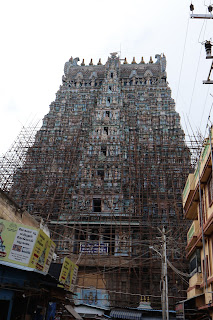Arulmigu Meenakshi Sundareswarar Temple is a historic Hindu temple located on
the southern bank of the Vaigai River in the temple city of Madurai, Tamil
Nadu, India.
It is dedicated to the goddess Meenakshi Amman, a form of Parvati, and her
consort, Sundareshwarar, a form of Shiva.
The west tower (gopuram) of the temple is the model based on which the Tamil
Nadu State Emblem is designed.
|
North tower (gopuram) seen from north
-
The shrines of Meenakshi temple are embedded inside three walled
enclosures and each of these have four gateways, the outer tower
growing larger and reaching higher to the corresponding inner one.
-
The temple has 14 gopurams, the tallest of which is the southern
tower, which rises to over 52 m (170 ft) and was rebuilt in the late
16th century.
-
The oldest gopuram is the eastern one, built by Maravarman Sundara
Pandyan during 1216–1238.
-
Each gopuram is a multi-storeyed structure, covered with sculpture
painted in bright hues.
-
The outer gopurams are high pyramidal tower serving as a landmark sign
for arriving pilgrims, while the inner gopuram are smaller and serve
as the entrance gateways to various shrines.
|
|
Horizontal panorama of the north tower seen from the northwest
Mottai gopuram (lit. "bald" gateway) was started by Krishnappa
Nayakkar, also called the North Raya gopuram.
It was completed by the Amaravati Purur Vayinagaram Chettiyar family in
1878 CE.
The Mottai gopuram for nearly three centuries did not have a roof
structure, is simpler and has fewer stucco images than the other major
entrances, giving it a relatively bald appearance and the local name.
Before its completion in the 19th century, the gopuram made of stone and
brick had even fewer stucco images.
|
|
Vertical panorama of the north tower seen from the northwest
The gopuram, or temple tower, is a significant feature in South
Indian temple architecture. Its various levels symbolize the journey
towards the divine.
-
Base Level (Bhooloka): The lowest level represents the earthly
realm, also known as Bhooloka. This is where humans reside, and it
signifies the material world and the everyday life of devotees.
-
Middle Levels (Antariksha): The middle tiers signify the
celestial space or Antariksha. This region represents the transitional
state between the earthly realm and the divine. It is often adorned
with sculptures of mythological figures and deities.
-
Upper Levels (Svarga): The higher levels symbolize Svarga, or
heaven. This is where the gods reside, and it represents spiritual
enlightenment and closeness to the divine. The upper levels are richly
decorated with intricate carvings and statues of deities, symbolizing
the devotee's journey towards spiritual awakening and union with the
divine.
-
Kalasha (Crowning Element): At the very top of the gopuram is
the kalasha, a pot-like structure often made of metal. It represents
the ultimate spiritual goal, the union with the divine, and the
attainment of moksha (liberation).
-
Each level of the gopuram thus symbolizes a step in the spiritual
ascent, guiding devotees from the material world to the spiritual
realm and, ultimately, to divine consciousness.
|
|
Detail panorama of the north tower seen from the northwest
At the top of the tower we can see Yali.
-
The Yali, often depicted as a mythical lion-like creature, plays a
significant role in Hindu temple architecture, particularly in South
India.
-
These fierce and protective beings are commonly found on gopurams, the
towering entrance gateways of temples.
-
Yalis symbolize strength, bravery, and the power to ward off evil
spirits.
-
They are considered guardians, protecting the sacred space within the
temple from negative influences.
-
Their placement on gopurams is both symbolic and aesthetic, as they
add to the grandeur and spiritual ambiance of the temple.
-
In essence, Yalis are not just ornamental but carry profound spiritual
meanings, representing the divine protection and the triumph of good
over evil.
|
|
West tower (gopuram) seen from north
|
|
Gold plated Vimanam (tower over sanctum) between the trees
The shrine for Sundareswarar is the largest within the complex
and its entrance is aligned with the eastern gopuram. The shrine for
Meenakshi is smaller, though theologically more important. Both the
Meenakshi and Sundareswarar shrines have gold plated Vimanam (tower over
sanctum).
-
The golden top can be seen from a great distance in the west through
the apertures of two successive towers.
|
See Also
Source
Location
Amma Mandapam Ghats, Srirangam
Ranganathaswamy Temple, Srirangam
Thirumalai Nayakkar Mahal, Madurai
Vandiyur Mariamman Teppakulam, Madurai


















